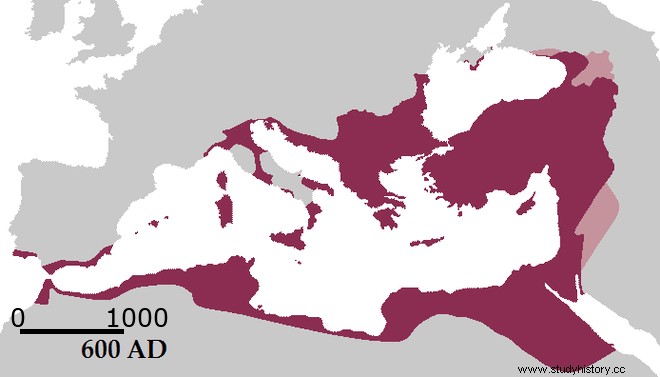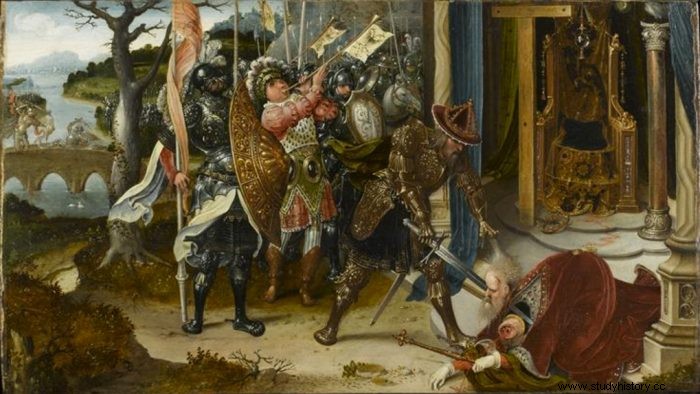To dare everything the peril must compel; You don't have to fear anything when you have everything to fear. (1)
The chiseled words of the poet Cornelius can only suit Heraclius (575-641), the Byzantine emperor who had the audacity to attack fate. If Constantinople will inevitably end up falling, a tour de force will prevent it from sinking too early in history. And yet, it took little for the Eastern Roman Empire to fall apart completely at the dawn of the 7th century AD.


Byzantine Empire around 600 (1) then around 650 (2).
An unrecognized emperor these days, his journey remains nonetheless extraordinary. Son of a governor; he will take the place of an emperor, fight with a weapon in hand, escape from an assassination attempt, disguise himself as a beggar, carry a piece of wood from the “alleged” cross of Christ and see all his conquests reduced to a trickle. If her life is literally a novel, it is because she survived in medieval imagery through her piety. Later, painters, from Jan de Beer to Miguel Ximenez, passing through 19th century engravings, paid tribute to him.

(4) Painting by Jan de Beer.
The first exploits
The young Heraclius, blond and with gray eyes, was born in eastern Anatolia. His father, of Armenian origin, was governor of the Roman province of Africa. Troubles in Constantinople incite them and then force them to return. Indeed, the incompetence of Emperor Phocas is about to be fatal to the Eastern Roman Empire. The chronicles will be bitter for a man whose mistakes were not only to continue them but also to aggravate them.
In October 610, Heraclius anchored off Constantinople. In view of the situation, radical measures are necessary:he easily deposes Phocas and has himself crowned emperor of a state in ruins. The situation is catastrophic:occupied by invaders on several fronts, Byzantium is ravaged by internal dissension. In short, the Slavs have invaded the Balkan Peninsula, the Persians occupy large parts of Anatolia, and the people of the Avars now demand tribute.
Beyond external threats, a leviathan gnaws at the bowels of the empire:the administration is disorganized, the economy is bloodless and the army is barely standing, exhausted and demoralized. Internal disturbances are not limited to isolated cases, the peasants are weakened by the continual exactions of the invaders and religious dissensions are rampant within Orthodoxy. And to top it off:the imperial authority is challenged by a powerful aristocracy. The Eastern Roman Empire lacked the strength to drive out the invaders, and perhaps not even to survive.
Heraclius was the one who initiated the militarization of Anatolia. To do this, He placed the Anatolian provinces under military governors and granted land grants not only to border soldiers, but also to soldiers and peasants in the interior, conditional on hereditary military service. The effects were revolutionary. A flexible defense developed in depth; a free and militarized peasantry was born.
With agriculture revived, the state was relieved of much of the burden of troop pay. Unruly mercenaries have largely been replaced by soldiers with a vested interest in protecting the empire.

(5) Painting by Piero della Francesca.
Ersatz chronicles
In 614, the Persians conquered Syria and Palestine, taking Jerusalem and what was believed to be the cross of Christ. Also, in an effort to appease the Avars, Heraclius agrees to meet them at Heraclea in Thrace (now Marmara Ereğli, Turkey) in 617 or 619. Thunderbolt, it's a trap! They are simply trying to capture him. He returns manu militari to Constantinople pursued by his enemies. Unaware of the origin of their treachery, he eventually made peace with them and was free to take the offensive against the Persians.
In 622, dressed as a penitent and bearing a sacred image of the Virgin, he left Constantinople, as prayers arose from its many shrines for victory over the Persian Zoroastrians and the retrieval of the cross and the reconquest of Jerusalem. . This act of piety will have its importance in the posthumous fame of the sovereign, in particular beyond its borders.
In a brilliant campaign, he maneuvered the Persians out of Anatolia and suggested a truce to the Persian monarch. This offer, Khosro II (or Chosroes, Sassanid emperor) rejects it with contempt, referring to himself as loved by the gods and master of the world. He vociferates Heraclius and insults Christ as incapable of saving his dying empire. Aware of the significance of such a statement, he broadcasts Khosro's response in public.
In 625, Heraclius retired to Anatolia. He had camped on the west bank of the Sarus River when Persian forces appeared on the opposite bank. Many of his men rushed impetuously across the bridge and were ambushed and annihilated by the enemy. Hurrying out of his tent, Heraclius saw the triumphant Persians crossing the bridge. The fate of the empire hung in the balance. Grabbing his sword, he ran to the bridge and slew the Persian leader. His soldiers closed the ranks behind him and repelled the enemy.
In 626, the Persians advanced towards the Bosphorus, hoping to join the Avars in an assault on the earthen walls of Constantinople. But the Byzantines sank the primitive Avar fleet which was to transport Persian units across the Bosphorus. The umpteenth assault of the Avars – people of nomadic horsemen – is repelled.
Heraclius again invaded Persia, and in December 627, after a march through the Armenian highlands in the Tigris Plain, he encountered the Persians near the ruins of Nineveh. There, astride his famous war horse, he killed three Persian generals in single combat, charged into the enemy ranks at the head of his troops. Ultimately, he killed the commander facing him and dispersed the Persian army.
A month later, Heraclius entered Dastagird (currently in Iraq) with great fanfare. Khosrau II was overthrown by his son, with whom Heraclius made peace, demanding in return the return of the Cross, the captives and the lost territory. Returning to Constantinople in triumph, he was hailed as, among others, a Moses, an Alexander and a Scipio.
In 630, he personally restored the cross in the Church of the Holy Sepulcher in Jerusalem.
These few chronological markers will not be substituted for a more in-depth reading of the situation of the Byzantine Empire and of the events explained through the supposed exploits of Heraclius (cf. PDF file “Sources and references”).

(6) Chronicle of Constantine Manasses on the rebellion of Heraclius
A Way of the Cross
But the successes eventually faded. Heraclius tried in vain to reconcile a uniform theological belief, “monothelitism” . In 634, exhausted by the confrontations and the years of anxiety within the Empire, he no longer took part in the fight. The Byzantine forces are thus defeated in a great battle on the Yarmuk (636). Soon Syria and later Egypt fell to the Arabs.
The Emperor's personal life was turned upside down, shortly before his death, with the death of his first wife, Fabia Eudocia. In fact, he married his niece, Martina, offending his contemporaries at the same time, vituperating Heraclius as incestuous. Suffering, possibly suffering from an enlarged prostate, retention of urine, inflammation broke out. After violent spasms, Heraclius died in February 641. The precise date remains uncertain.
A military leader inspiring both religious fervor and personal fearlessness, Heraclius had constant concern for his men. A cautious and calculating strategist, he fought less inhuman wars than most of his contemporaries. He did not enslave or slaughter the inhabitants of conquered cities. Likewise, he freed the prisoners, instead of starving them to death.
His piety is also praised with this anecdote:in 623 his victorious soldiers wanted to penetrate deeper into Persia, contrary to his plan to withdraw; so he referred the matter to God. After his troops had fasted and prayed for three days, he opened the Bible in their presence, seemingly at random, and read a passage that could only be interpreted as a divine command to stand down. The medieval world could not but be receptive to this attention.
The jewel of Byzantium thus withstood the repeated assaults of the outside world, and probably saved the Byzantine Empire, allowing it in fine to hold up to 1453.
Sources and references:
(1) Pierre Corneille, Heraclius, Act I, Sc. V.
– The illustration for the article is a two-sided medallion depicting the Roman Emperor Heraclius in the 7th century, who is believed to have was modeled on the Emperor Manuel II Palaiologos (made in – France around 1400), Museum of Fine Arts, Boston
– Chronicle of Constantine Manassès
– The Emperor Heraclius And The Byzantine Empire In The Seventh Century , Ludovic Drapeyron
– Larousse
– Universalis
